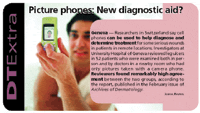- Acne
- Actinic Keratosis
- Aesthetics
- Alopecia
- Atopic Dermatitis
- Buy-and-Bill
- COVID-19
- Case-Based Roundtable
- Chronic Hand Eczema
- Chronic Spontaneous Urticaria
- Drug Watch
- Eczema
- General Dermatology
- Hidradenitis Suppurativa
- Melasma
- NP and PA
- Pediatric Dermatology
- Pigmentary Disorders
- Practice Management
- Precision Medicine and Biologics
- Prurigo Nodularis
- Psoriasis
- Psoriatic Arthritis
- Rare Disease
- Rosacea
- Skin Cancer
- Vitiligo
- Wound Care
Article
Physician: Heal thy practice
Miami — No doctor would treat a patient as haphazardly as many seem to treat their practices. From improper coding to trust placed in the wrong people, many physicians' practices suffer from a variety of treatable ills, according to Mark S. Nestor, M.D., Ph.D., director, Center for Cosmetic Enhancement, and clinical associate professor of dermatology and cutaneous surgery at the University of Miami School of Medicine, Miami.

Most common mistake "The most common mistake is: People don't bill and code correctly, and they lose money or have problems down the line when they get audited because they don't properly document what they've coded," Dr. Nestor tells Dermatology Times. "Too many dermatologists are terrible business people and rely on office staff to do a lot of tasks that they should look over themselves," he adds. "Unfortunately, because of that, there are a lot of issues with theft and other problems that can occur."
Three categories Dr. Nestor divides practice management into three categories - compliance, effectiveness and efficiency.
"All of these need to be taken into account," Dr. Nestor says. "And a small physician practice very often has difficulty being compliant with these various issues. It's very expensive, and it often underscores the benefits of group practices, where a lot of this can be done for a group of physicians."
Outside vendors Similarly, growing numbers of practitioners are contracting with outside management companies to handle these functions, and with purchasing cooperatives designed to achieve cost savings.
At the same time, more physicians are joining group practices that are organized into separate profit centers. This arrangement confers benefits such as group buying power, while allowing individual centers to earn and spend on their own, albeit within group guidelines.
"This has proven to be one of the most successful models of practice management. It tends to both keep costs down and allow for efficiencies of scale of the practice in general," he says.
Physician extenders Potentially, the use of physician extenders is the most controversial element of achieving practice efficiency.
"When used properly, physician extenders can really add to patient care and, at the same time, allow one to be more efficient in one's practice. Part of the key is that any physician extender can aid in your practice. It doesn't have to be a physician assistant (PA) or nurse practitioner. Medical assistants or nurses can take histories, perform some injections and do a lot to provide a helping hand to the physician," Dr. Nestor says.
One of the most significant changes in recent years is the use of physician assistants and nurse practitioners to perform not only procedures, but also patient care.
For instance, Dr. Nestor uses four PAs to handle various tasks ranging from patient follow-up to suture removal and nonablative laser treatments.
"What's important is that they don't take the place of a dermatologist," he tells Dermatology Times. "I see all new patients and all new problems (except for the occasional emergency). So, it's a partnership where there's a tremendous degree of assistance in terms of procedures and ongoing care, education and evaluation. But the actual diagnosis of the problem and setting up a management plan falls to me."
Newsletter
Like what you’re reading? Subscribe to Dermatology Times for weekly updates on therapies, innovations, and real-world practice tips.
















